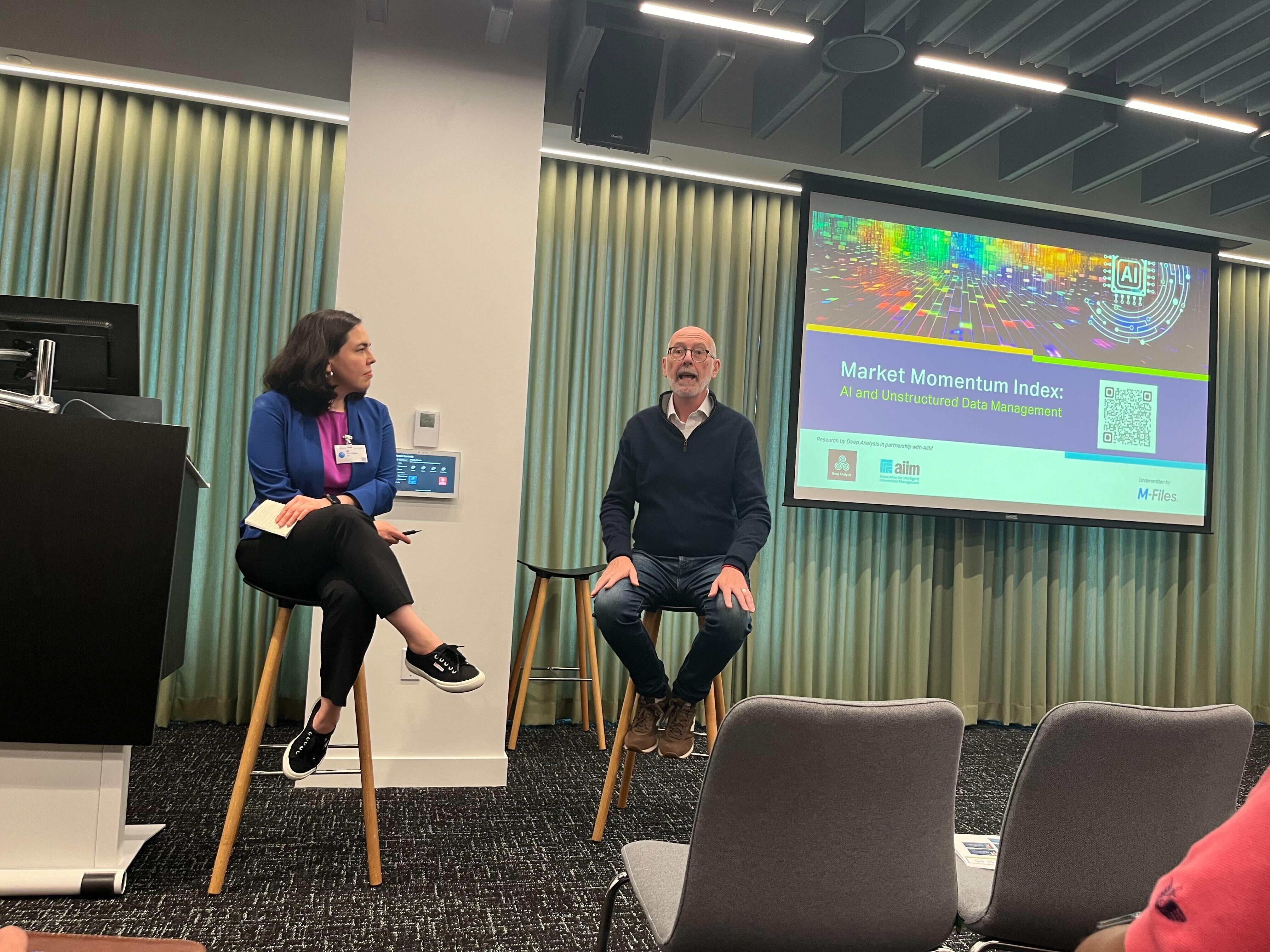
The 2025 Information Management Tech Stack
Process Automation | Artificial Intelligence (AI)
On October 1, 2024, at the AIIM Information and Data Leadership Symposium in Arlington, VA, I had an enlightening conversation with Alan Pelz-Sharpe, Founder of Deep Analysis. Our discussion centered on a crucial question: What should your organization's information management technology stack look like in 2025 to maximize the benefits of AI and process automation?
As you put the finishing touches on your 2025 budget, it's the perfect time to gain insights into the essential tools, platforms, and architectures that will empower your organization to stay ahead of the curve. Let's dive into the key takeaways from our conversation.
The Evolution of Information Management Systems
Twenty years ago, there was a push towards centralizing information in a single hub – the Enterprise Content Management (ECM) System. However, times have changed. According to the 2024 AIIM State of the Intelligent Information Management Practice report, most organizations now have an average of 10+ information management systems.
Why the shift? Line of business leaders require best-of-breed systems to accomplish their specific goals. This means that fighting against information sprawl and ever-growing technology stacks is both futile and counterproductive.
Instead, organizations should focus on identifying tools and practices that enable three key factors:
1. Interoperability between systems
2. Data access
3. Data hygiene
These three elements are essential for success with AI initiatives.
Systems and Platforms to Investigate
Pelz-Sharpe highlighted three systems that organizations should be investigating and leveraging in 2025:
1. Enterprise Search: Surprisingly, only 16% of respondents in AIIM's research currently use enterprise search, with just 18% indicating plans to use it in the future. However, Pelz-Sharpe pointed out that Enterprise Search tools already have interoperability with existing systems and experience with AI and enterprise data, making them ideal partners for future AI initiatives.
2. Document Management Systems (DMS): 53% of respondents said their organization uses or plans to use document management systems. Pelz-Sharpe noted that DMS are valuable for providing a repository of clean, maintained, and accurate data for AI models.
3. Workflow and Process Automation: 63% of respondents use or plan to use workflow and process automation tools. Pelz-Sharpe explained that big players like Salesforce and Oracle are combining accurate data with automation and appealing user interfaces to facilitate more efficient processes and, in some cases, replacing human labor.
Technological Capabilities to Explore
The Market Momentum Index, a report by Deep Analysis supported by M-Files and AIIM, surveyed over 500 senior executives and found that just over 20% intend to invest in Robotic Process Automation (RPA).
Pelz-Sharpe explained that while RPA may be out of fashion, it does an excellent job of addressing specific use cases. He recommended adopting lighter footprints with RPA, investigating how to use it for discrete problems. Notably, the RPA industry experienced a 30% growth rate in 2024.
Leveraging AI for Information Management
Generative AI has gained popularity for content generation and information creation. However, it's less popular among respondents of AIIM's State of the Intelligent Information Management report when it comes to governing and managing information.
Pelz-Sharpe explained that generative AI technology isn't mature enough yet to adequately assist in critical tasks like metadata generation, data hygiene, or managing retention rules. However, automation tools continue to help organizations manage the high volume of unstructured data.
Challenges in Leveraging AI Effectively
One of the main obstacles organizations face in leveraging AI effectively is a lack of workforce talent who can develop and manage workflow and process automation. Automation requires professionals with systems thinking skills rather than just development expertise.
"The bottleneck is a lack of skills, not the technology," said Pelz-Sharpe. "There is a misconception that software will solve the problems."
Pelz-Sharpe predicted that we are on a ten-year journey with AI, with the next 3-5 years being critical as organizations implement more focused AI projects.
Directing Spending and Resources
When asked about where organizations are directing the increasing spending on unstructured data management, 50.4% of respondents to the Market Momentum Index agreed there will be an increase in software costs, while only 11.7% said there will be an increase in employee costs.
However, Pelz-Sharpe emphasized the importance of knowledgeable people to advance AI projects. "Hire people who know what they're talking about," he advised.
He also discussed the importance of:
- Developing strong business cases for AI
- Reevaluating how organizations budget for AI
Pelz-Sharpe noted that more software providers are moving away from licensing based on the number of seats to licensing based on transactions. This shift makes sense as AI could potentially decrease workforce size, making seat-based licensing less reliable for software providers.
The Future of Generative AI for the Enterprise
According to Pelz-Sharpe, the hype cycle around generative AI has passed, and we're now entering a more realistic phase. Digital assistants currently show the most promise in enterprise applications.
He believes we're in a 5-10 year growth cycle:
- In 2-5 years, generative AI will be enterprise-ready
- In 5-10 years, it will be commonplace in the enterprise
When asked what organizations should be doing now to prepare, Pelz-Sharpe advised focusing on testing and experimenting with AI through discrete projects where you have high-quality data. "AI is fantastic when data is good, and terrible when the data is bad," he emphasized.
As we look towards 2025, organizations need to focus on interoperability, data access, and data hygiene while investing in the right mix of technologies and, crucially, the right talent to drive AI initiatives forward. By taking a measured, strategic approach to AI adoption, businesses can position themselves to reap the benefits of this transformative technology in the years to come.
About Tori Miller Liu, CIP
Tori Miller Liu, MBA, FASAE, CAE, CIP is the President & CEO of the Association for Intelligent Information Management. She is an experienced association executive, technology leader, speaker, and facilitator. Previously, she served as the Chief Information Officer of the American Speech-Language-Hearing Association (ASHA) and been working in association management since 2006. Tori is a current member of the ASAE Executive Management Advisory Council and Association Coalition for AI. She is a former member of the ASAE Technology Professional Advisory Council and a former Board Member of Association Women Technology Champions. She was named a 2020 Association Trends Young & Aspiring Professional and 2021 Association Forum Forty under 40 award recipient. She is also an alumna of the ASAE NextGen program. She is a Certified Association Executive and holds an MBA from George Washington University. In 2023, Tori was named as a Fellow of the American Society of Association Executives (ASAE).

